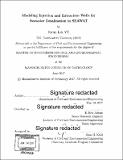Modeling injection and extraction wells for seawater desalination in SEAWAT
Author(s)
Yu, Kwun Lok
DownloadFull printable version (8.784Mb)
Other Contributors
Massachusetts Institute of Technology. Department of Civil and Environmental Engineering.
Advisor
E. Eric Adams.
Terms of use
Metadata
Show full item recordAbstract
Subsurface intakes and disposal systems are gaining interest for seawater desalination in comparison with the older open ocean intake/discharge systems that induce many environmental problems. Facilities using reverse-osmosis technology to desalinate seawater require stringent feed water quality to operate efficiently, and are particularly prone to membrane fouling when contaminants enter the system. Subsurface systems leverage coastal aquifers as natural filters, increasing the effective flow field for seawater extraction and brine disposal, and are proven to reduce impacts on the coastal environment. In this study, we developed groundwater models in SEAWAT, a three-dimensional finite difference groundwater model capable of simulating a varying-density environment, to learn about the interactions of seawater, brackish water, freshwater and brine due to extraction and injection activities, with salinities ranging from 0-70 PSU, and densities ranging from 10009/L to 10509/L. Two hypothetical desalination plants with freshwater production rates adequate to supply 750 people and 7500 people were simulated. Using simplified cross-sectional two-dimensional models, an optimal offshore location can be identified to implement subsurface intake systems to extract seawater closest to the coastline while minimizing impacts on existing freshwater storage from seawater intrusion. Models have also shown that for the same desalination plants, the coastal aquifer is more tolerant of brine injection than feedwater extraction; given that desalination plants typically have a 50% efficiency, half of the extracted seawater becomes freshwater, and only the remaining wasted brine is injected into the aquifer. A 2D test model with an expanded longshore domain, as well as a 3D test model with non-uniform properties in the longshore direction were also developed to test sensitivity when the longshore domain is changed.
Description
Thesis: M. Eng., Massachusetts Institute of Technology, Department of Civil and Environmental Engineering, 2017. Cataloged from PDF version of thesis. Includes bibliographical references (pages 67-68).
Date issued
2017Department
Massachusetts Institute of Technology. Department of Civil and Environmental EngineeringPublisher
Massachusetts Institute of Technology
Keywords
Civil and Environmental Engineering.